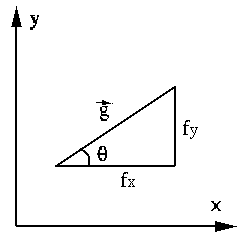The Gradient (also called the Hamilton operator) is a vector
operator for any N-dimensional scalar function
 ,
where
,
where
![${\bf x}=[x_1,\cdots,x_N]^T$](img16.svg) is an N-D vector variable. For example,
when
is an N-D vector variable. For example,
when  ,
,
 may represent temperature, concentration, or pressure
in the 3-D space. The gradient of this N-D function is a vector composed of
may represent temperature, concentration, or pressure
in the 3-D space. The gradient of this N-D function is a vector composed of  components for the
components for the  partial derivatives:
partial derivatives:
![$\displaystyle {\bf g}({\bf x})=\bigtriangledown f({\bf x})=\frac{d}{d{\bf x}}f(...
...bf x})}{\partial x_1},\cdots,
\frac{\partial f({\bf x})}{\partial x_N}\right]^T$](img20.svg) |
(10) |
- The direction
 of the gradient vector
of the gradient vector  is the
direction in the N-D space along which the function
is the
direction in the N-D space along which the function
 increases
most rapidly.
increases
most rapidly.
- The magnitude
 of the gradient
of the gradient  is the rate of the
increment.
is the rate of the
increment.
In image processing we only consider 2-D field:
![$\displaystyle \bigtriangledown=\left[\begin{array}{c}
\frac{\partial}{\partial x}\\ \\ \frac{\partial}{\partial y} \end{array}\right]$](img24.svg) |
(11) |
When applied to a 2-D function  , this operator produces a vector
function:
, this operator produces a vector
function:
![$\displaystyle {\bf g}=\bigtriangledown f(x,y)
=\left[ \begin{array}{c}\frac{\pa...
... \end{array} \right]
=\left[ \begin{array}{c} f_x \\ \\ f_y \end{array} \right]$](img26.svg) |
(12) |
where
 and
and
 .
The direction and magnitude of
.
The direction and magnitude of  are respectively
are respectively
 |
(13) |
Now we show that  increases most rapidly along the direction of
increases most rapidly along the direction of
 and the rate of increment is equal to the magnitude
of
and the rate of increment is equal to the magnitude
of
 .
.

Consider the directional derivative of  along an arbitrary
direction
along an arbitrary
direction  :
:
 |
(14) |
This directional derivative is a function of  , defined as the
angle between directions
, defined as the
angle between directions  and the positive direction of
and the positive direction of  . To find
the direction along which
. To find
the direction along which  is maximized, we let
is maximized, we let
 |
(15) |
Solving this for  , we get
, we get
 |
(16) |
i.e.,
 |
(17) |
which is indeed the direction
 of
of
 .
.
From
 , we can also get
, we can also get
 |
(18) |
Substituting these into the expression of  , we obtain its maximum
magnitude,
, we obtain its maximum
magnitude,
 |
(19) |
which is the magnitude of
 .
.

![${\bf x}=[x_1,\cdots,x_N]^T$](img16.svg)




![$\displaystyle {\bf g}({\bf x})=\bigtriangledown f({\bf x})=\frac{d}{d{\bf x}}f(...
...bf x})}{\partial x_1},\cdots,
\frac{\partial f({\bf x})}{\partial x_N}\right]^T$](img20.svg)
 of the gradient vector
of the gradient vector  is the
direction in the N-D space along which the function
is the
direction in the N-D space along which the function
 increases
most rapidly.
increases
most rapidly.
 of the gradient
of the gradient  is the rate of the
increment.
is the rate of the
increment.
![$\displaystyle \bigtriangledown=\left[\begin{array}{c}
\frac{\partial}{\partial x}\\ \\ \frac{\partial}{\partial y} \end{array}\right]$](img24.svg)
 , this operator produces a vector
function:
, this operator produces a vector
function:
![$\displaystyle {\bf g}=\bigtriangledown f(x,y)
=\left[ \begin{array}{c}\frac{\pa...
... \end{array} \right]
=\left[ \begin{array}{c} f_x \\ \\ f_y \end{array} \right]$](img26.svg)
 and
and
 .
The direction and magnitude of
.
The direction and magnitude of  are respectively
are respectively








 , defined as the
angle between directions
, defined as the
angle between directions  and the positive direction of
and the positive direction of  . To find
the direction along which
. To find
the direction along which  is maximized, we let
is maximized, we let

 , we get
, we get


 of
of
 .
.


 , we obtain its maximum
magnitude,
, we obtain its maximum
magnitude,

 .
.